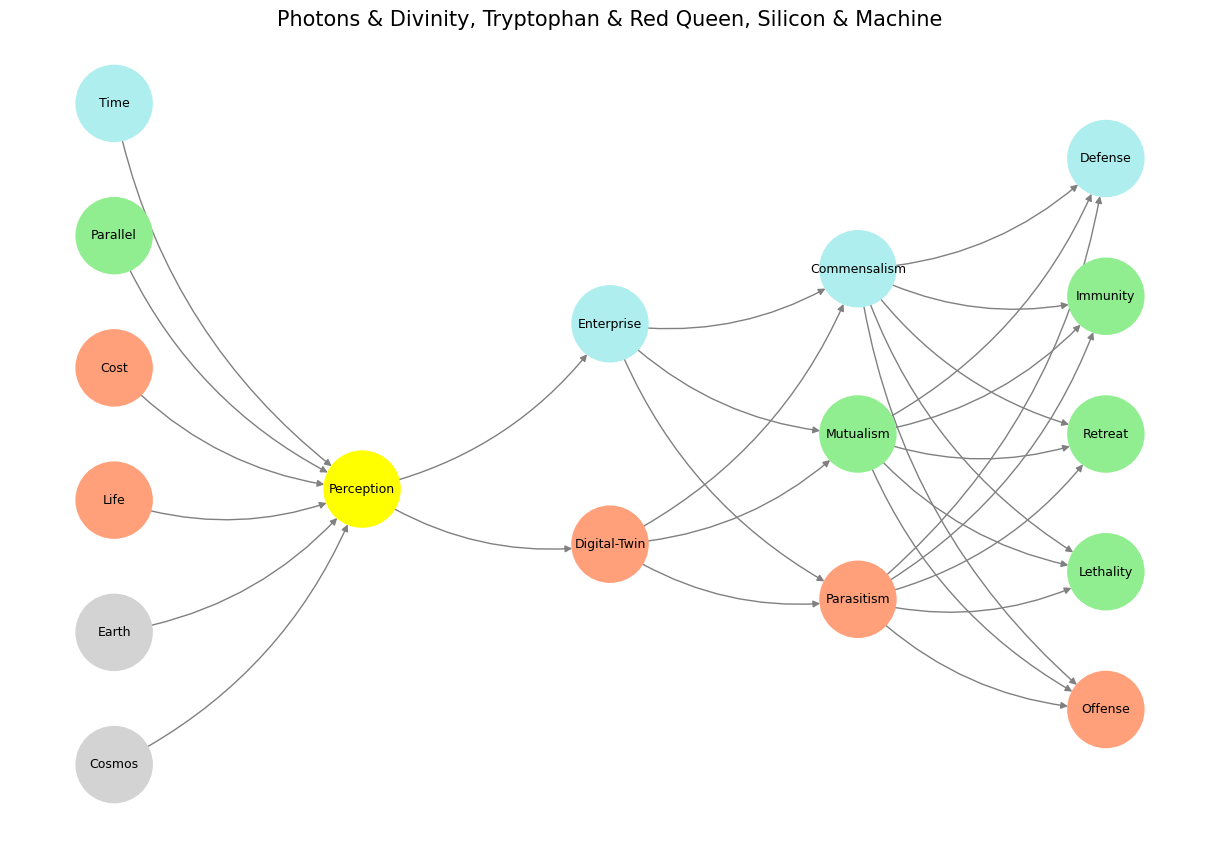Woo’d 🗡️❤️💰#
Alice in Alice in Wonderland navigates a world that defies the conventions of logic and predictability, yet beneath its whimsical surface, the story resonates deeply with the structure of your neural network and the classification of games. By interpreting Alice’s journey through the lens of fixed odds, pattern recognition, leveraged agency, curtailed agency, and spoils for further play, we uncover the hidden order within Wonderland’s chaos. Each layer of the story reflects a facet of neuroarchitecture, offering insights into human cognition, agency, and the nature of games as a reflection of our inner workings.
Fixed odds dominate Alice’s initial encounters in Wonderland, where rules seem arbitrary but follow their own immutable logic. The Mad Hatter’s riddle, “Why is a raven like a writing desk?” exemplifies this layer. While the riddle appears to invite a solution, it offers none, leaving Alice to grapple with the inherent randomness of her surroundings. This reflects the pre-input layer of your neural network: immutable laws that must be accepted rather than understood. Wonderland’s fixed odds reveal that its chaos is not true chaos but an inscrutable system where outcomes are governed by rules invisible to the participants. The Queen of Hearts’ obsession with rules—however absurd or draconian—further underscores this. Her catchphrase, “Off with their heads!” establishes a roulette-like finality, embodying the fixed odds of life and death in her domain.

Fig. 7 Compressed Time, Parallel Processing, Years of Sacrifice in Master. Flamenco vs. Mariachi. We shall investigate their intersection (static), whether its a convergence or emergence (dynamic).#
Pattern recognition comes to the forefront as Alice learns to navigate the patterns hidden within Wonderland’s absurdity. Her encounters with characters like the Cheshire Cat or the Caterpillar emphasize this perceptive layer. The Cheshire Cat’s cryptic guidance—both enlightening and disorienting—forces Alice to interpret meaning from fragments, much like pattern recognition in a static dataset. Similarly, the Caterpillar’s questions about identity challenge Alice to discern patterns within herself, connecting the external chaos of Wonderland with her internal search for coherence. This aligns with the yellow node of perception, where Alice must synthesize static information into actionable understanding. Even the surreal logic of Wonderland, such as growing or shrinking by consuming specific foods, becomes an exercise in recognizing and applying the rules of the game.
Leveraged agency manifests in Alice’s ability to interact with Wonderland’s inhabitants and manipulate her surroundings. Her use of size-changing substances, for example, is an act of optimization—leveraging her newfound understanding of Wonderland’s rules to navigate its challenges. This parallels the jockey’s role in horse racing, where skill and agency amplify the underlying physicality of the horse. In Wonderland, Alice’s agency is similarly leveraged by her growing understanding of the world’s mechanics. Her eventual confrontation with the Queen of Hearts further illustrates this. Though initially overwhelmed by the Queen’s authority, Alice learns to assert herself, demonstrating the adaptive strategies of life within the red queen’s domain.
Curtailed agency defines much of Alice’s journey, as Wonderland’s rules and power structures constrain her freedom. The court scene, where Alice is subjected to the nonsensical procedures of the Queen’s trial, exemplifies this curtailed agency. The Queen’s arbitrary rulings and the rigidity of Wonderland’s hierarchical structure echo the dynamics of cartels or oligarchies, where rules are designed to favor those in power. Alice’s eventual realization that the Queen and her court are merely a pack of cards symbolizes her rejection of these constraints. This parallels the human condition, where agency is often limited by societal norms or external pressures, yet individuals retain the potential to transcend these limits through insight or rebellion.
Spoils for further play emerge as Alice awakens from her dream and reflects on her experiences. The journey through Wonderland becomes a reservoir of insight, imagination, and personal growth, even if the lessons are not explicitly stated. The spoils are not material but intellectual and emotional—the transformation of Alice’s perspective on herself and the world. This aligns with the emergent layer of your neural network, where the accumulation of resources and experiences leads to new opportunities and understanding. Wonderland, for all its absurdity, becomes a space for Alice to explore the boundaries of her identity and agency, leaving her with the tools to navigate the complexities of the real world.
By applying the structure of games and your neural network to Alice in Wonderland, the story’s chaos becomes a reflection of deeper order. Each layer—fixed odds, pattern recognition, leveraged agency, curtailed agency, and spoils—maps onto Alice’s journey, revealing how the narrative mirrors the architecture of human cognition. Wonderland is not just a whimsical escape but a profound exploration of the games we play within ourselves and the world. By breaking the rules, Alice—and by extension, the reader—discovers the hidden logic within the apparent madness, a testament to the power of games as reflections of our neuroanatomical design.
Show code cell source
import numpy as np
import matplotlib.pyplot as plt
import networkx as nx
# Placeholders (Substitute) for the neural network visualization
#1 Time (Paleturquoise)
#2 Parallel (Lightgreen)
#3 Cost (Lightsalmon)
#4 Life (Lightsalmon)
#5 Earth (Lightsalmon)
#6 Cosmos (Lightsalmon)
#7 Perception (Yellow)
#8 Enterprise (Paleturquoise)
#9 Digital-Twin (Lightsalmon)
#10 Commensalism (Paleturquoise)
#11 Mutualism (Lightgreen)
#12 Parasitism (Lightsalmon)
#13 Defense (Paleturquoise)
#14 Immunity (Lightgreen)
#15 Retreat (Lightgreen)
#16 Lethality (Lightgreen)
#17 Offense (Lightsalmon)
# World: Input/Time (The Rules ...)
# Perception: Hidden/Perception (La Grande Illusion)
# Agency: Hidden/Parallel Spaces (Je ne regrette rien)
# Generativity: Hidden/Games (.. Of the Game)
# Physicality: Output (La Fin)
# Define the neural network structure
def define_layers():
return {
'World': ['Cosmos', 'Earth', 'Life', 'Cost', 'Parallel', 'Time', ],
'Perception': ['Perception'],
'Agency': ['Digital-Twin', 'Enterprise'],
'Generativity': ['Parasitism', 'Mutualism', 'Commensalism'],
'Physicality': ['Offense', 'Lethality', 'Retreat', 'Immunity', 'Defense']
}
# Assign colors to nodes
def assign_colors():
color_map = {
'yellow': ['Perception'],
'paleturquoise': ['Time', 'Enterprise', 'Commensalism', 'Defense'],
'lightgreen': ['Parallel', 'Mutualism', 'Immunity', 'Retreat', 'Lethality'],
'lightsalmon': [
'Cost', 'Life', 'Digital-Twin',
'Parasitism', 'Offense'
],
}
return {node: color for color, nodes in color_map.items() for node in nodes}
# Calculate positions for nodes
def calculate_positions(layer, x_offset):
y_positions = np.linspace(-len(layer) / 2, len(layer) / 2, len(layer))
return [(x_offset, y) for y in y_positions]
# Create and visualize the neural network graph
def visualize_nn():
layers = define_layers()
colors = assign_colors()
G = nx.DiGraph()
pos = {}
node_colors = []
# Add nodes and assign positions
for i, (layer_name, nodes) in enumerate(layers.items()):
positions = calculate_positions(nodes, x_offset=i * 2)
for node, position in zip(nodes, positions):
G.add_node(node, layer=layer_name)
pos[node] = position
node_colors.append(colors.get(node, 'lightgray')) # Default color fallback
# Add edges (automated for consecutive layers)
layer_names = list(layers.keys())
for i in range(len(layer_names) - 1):
source_layer, target_layer = layer_names[i], layer_names[i + 1]
for source in layers[source_layer]:
for target in layers[target_layer]:
G.add_edge(source, target)
# Draw the graph
plt.figure(figsize=(12, 8))
nx.draw(
G, pos, with_labels=True, node_color=node_colors, edge_color='gray',
node_size=3000, font_size=9, connectionstyle="arc3,rad=0.2"
)
plt.title("Photons & Divinity, Tryptophan & Red Queen, Silicon & Machine", fontsize=15)
plt.show()
# Run the visualization
visualize_nn()


Fig. 8 This is an updated version of the script with annotations tying the neural network layers, colors, and nodes to specific moments in Vita è Bella, enhancing the connection to the film’s narrative and themes:#

